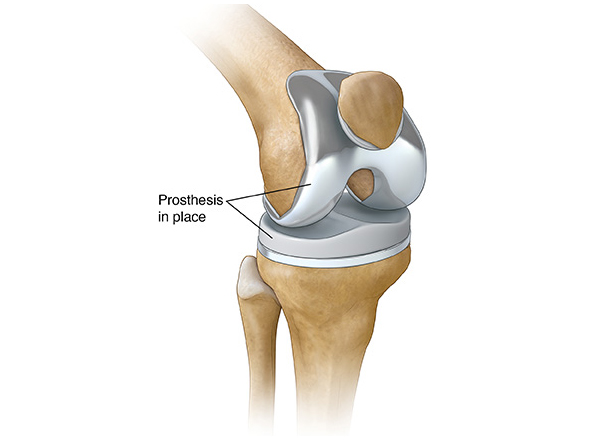
In a standard knee replacement the aim is to 'resurface' the end of the bone. Small amounts of bone and remaining joint suface cartilage are removed and resurfaced with metal and plastic. Parts of the femur and tibia bone are cut and resurfaced with metal, inbetween a piece of plastic is used. If the kneecap is also degenerated, this can also be resurfaced.
There are many conditions which require a knee replacement. The most common is osteoarthritis. This means that the cartilage of the knee has worn out, resulting in the top of the shinbone (tibia) and the bottom of the thigh bone (femur) rubbing together. This is very painful and stops you from being able to move your knee as you once did.
A TKR involves removing the end of the thigh bone, and the top of the shinbone, and replacing them with prostheses (artificial knee implants). The artificial knee is usually made of metal alloy and high-density plastic.
Before your operation, one of the surgical team will discuss the procedure with you and answer any other questions you may have. You will also be asked to sign a form, giving your consent to the operation.
The anaesthetist will visit you before your operation to discuss your anaesthetic options.
You will be told not to eat for approximately six hours and drink for two hours before your operation, depending on your anaesthetist's instructions. Failure to follow these instructions will result in your operation being delayed or even cancelled.
Our porters will take you to the operating theatre and a nurse will accompany you and hand you over to the care of the theatre team. The operation usually takes between one and one and a half hours. You may be away from the ward longer than this as you will be taken to the recovery area and cared for there until you are well enough to return to the ward.
A partial knee replacement is surgery to replace only one part of a damaged knee. It can replace either the inside (medial) part, the outside (lateral) part, or the kneecap part of the knee.
Partial knee replacement surgery removes damaged tissue and bone in the knee joint. It is done when arthritis is present in only part of the knee. The areas are replaced with a man-made implant, called a prosthetic. The rest of your knee is preserved. Partial knee replacements are most often done with smaller incisions, so there is less recovery time.
Before surgery, you will be given medicine that blocks pain (anesthesia). You will have one of two anesthesia types: